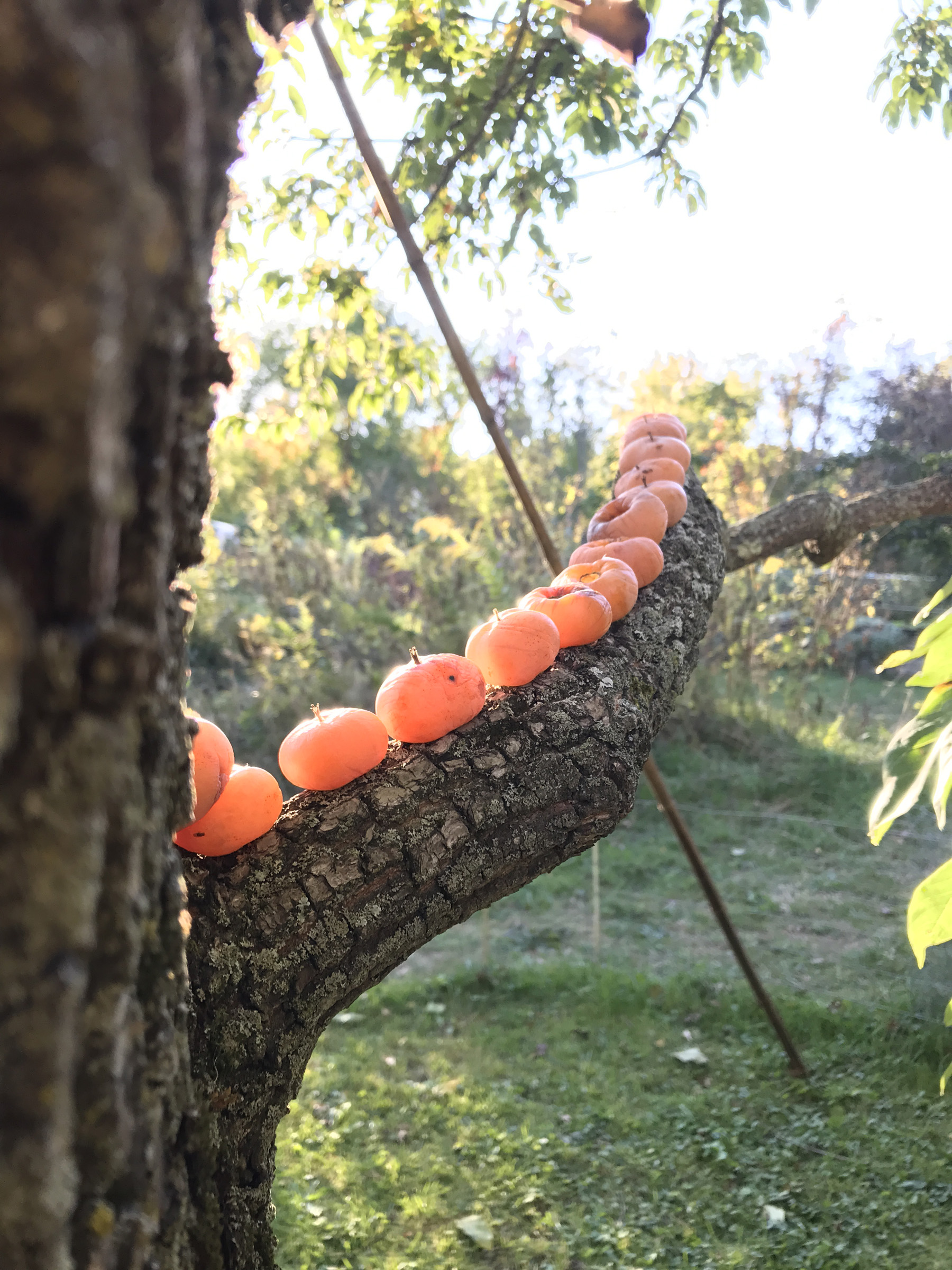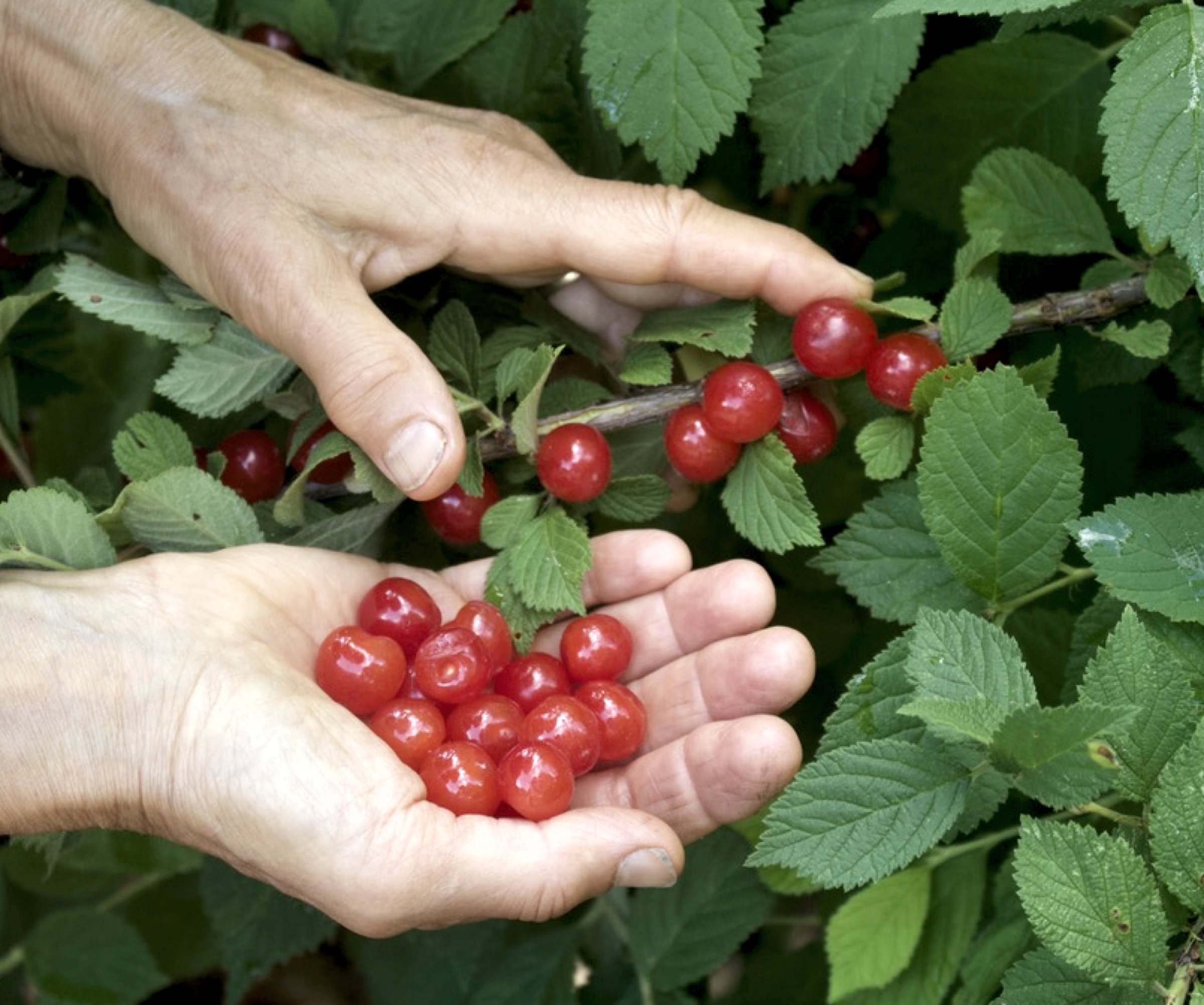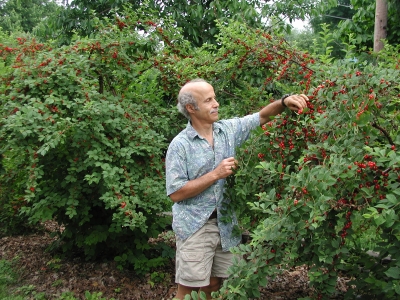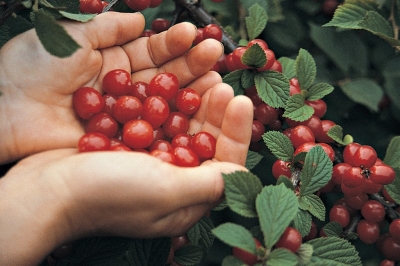My Nanking cherries (Prunus tomentosa) made a lot of people happy this year. Joy was first spread in early April as thousands of pinkish white flowers burst open along the stems, enough to almost completely hide the stems. Passers-by enjoyed the hedge of plants, which run along the driveway; some people even asked about the name of the plant.
In early June, the blossoms morphed into small, red cherries, oodles and oodles of them. Now, the end of June as I write, just a few cherries still cling to the stems. Throughout the month of June, though, friends, strangers, relatives, birds, chipmunks, and creatures unseen feasted on the abundance.
Nanking cherries are admittedly small and somewhat hard to harvest because they cling closely to the stems on short stalks, but these two deficiencies are far offset by the care the plants need. Almost none! Every few years, I whack back some stems that become decrepit or send the plant high or wide out of bounds.. And I usually spread wood chips or leaves beneath the bushes as mulch to suppress weeds and conserve soil moisture. But neither of these minor tasks is absolutely necessary.
Perhaps the most amazing thing about Nanking cherries is that there are no improved varieties. That is, they are all random seedlings, each a genetic individual. Yet they all taste good, ranging in flavor and texture, depending on the individual, from almost sweet to sour cherry. (Compare this to wild apples, which pretty much all taste bad; the good-tasting apples that we have are the result of hundreds of years of selection and breeding.) Nanking cherry fruits are small, as are the wild cherries from which cultivated cherries are derived.

One of my bushes yields cherries that are slightly larger, slightly firmer and, hence, easier to harvest, and slightly sweeter than my other 10 or so bushes. Seeds from that bush didn’t get spit on the ground; I collected them for planting. Nanking cherry bushes bear fruit within a couple of years and repeated selection of plants bearing the best fruits could result in bigger and better fruits. Improvements might also come from widening the genetic input with pollen from a wider range of Nanking cherry individuals and even some related species, such as sweet cherry. The combination of Nanking cherry’s tolerance to winter cold, late spring frosts, and insect and disease pests and sweet cherry’s fruit size, sweeter flavor, and firmness would make a plant that was easy to grow with even tastier fruits.
I’ll report back in years to come. For now, run-of-the-mill Nanking cherry is well worth growing and another perfect fruit for ambulant consumption on the way to the front door or to the mailbox at the end of the driveway.
—————————————————–
I have a good excuse for the weediness of one of my gardens: It’s on a roof, not an area I frequently walk past with the opportunity to pull a few weeds. I would have to get a ladder and, because this garden is not to be walked on, reach in as far as possible. I don’t weed it.
This garden is a “green roof” covering a front porch. Green roofs absorb rainfall and the sun’s heat, insulate whatever is below, and look — well — green and alive. The last reason prompted my roof planting about ten years ago.
 |
| Original hens-and-chicks laid on roof |
But first I had to build the porch roof. Construction was standard — oak posts and crossbeam with 2 by 8 joists covered by 1 by 6 planks — except for the covering of rubber roofing bonded to copper flashing provided with weep holes at the lower end. Planting was begun the year before with hens and chicks (Sempervivum spp.) in seedling flats filled with a mix of equal parts peat moss and calcined montmorillonite clay (the latter also known as “kitty litter). That spring I snuggled the flats next to each other on the roof. Setting flats on the roof intact would, and did, prevent rainfall from washing the planting mix and plants down the slope, the angle of which was determined mostly by aesthetics. I wanted the top of the roof just visible from the driveway.
The goal was for the hens and chicks to make more chicks, and those chicks to make even more chicks, spreading to make a dense, blue-green mat over the surface and draping over the lower eave. They didn’t spread thoroughly or fast enough.
 |
| Angelina now filling in the roof |
It takes a tough plant to survive and grow on this roof. The soil mix is only a couple of inches deep so plant roots are exposed to the full brunt of winter cold and summer heat, and the roof gets only natural rainfall. Because hens and chicks weren’t fully up to the task, I started planting other succulents to fill in bare areas amongst the hens and chicks.
Over the years, the most successful of these plants has been Sedum rupestre ‘Angelina’. Not only does ‘Angelina’ survive and grow under the austere conditions, but she also looks pretty year ‘round. Right now, the plant is a trailing mat of fleshy, pointed, pale green leaves up through which push foot-high shoots capped with clusters of yellow flowers. In fall and winter, the leaves take on an amber hue. The plants root very easily to furnish new ones to fill in the few remaining bare spots. I pluck off pieces of shoots and toss them back onto the roof to eventually root and spread. Very convenient.
———————————————
It’s hard to imagine how weeds have gotten onto my green roof, let alone survive. Birds and wind, no doubt, got the plants there. The weeds include fleabanes and some grasses. Some people tell me that these “weeds” look pretty up on the roof, so maybe they’re not weeds. The fleabanes, now in bloom, hold their white, daisy-like flowers high above those of ‘Angelina’. And, if nothing else, both weeds . . . whoops, I mean plants . . . hold the soil in place as ‘Angelina’ continues to spread.
———————————————








